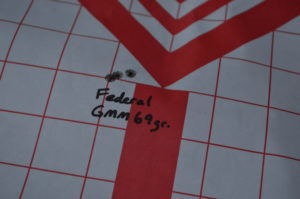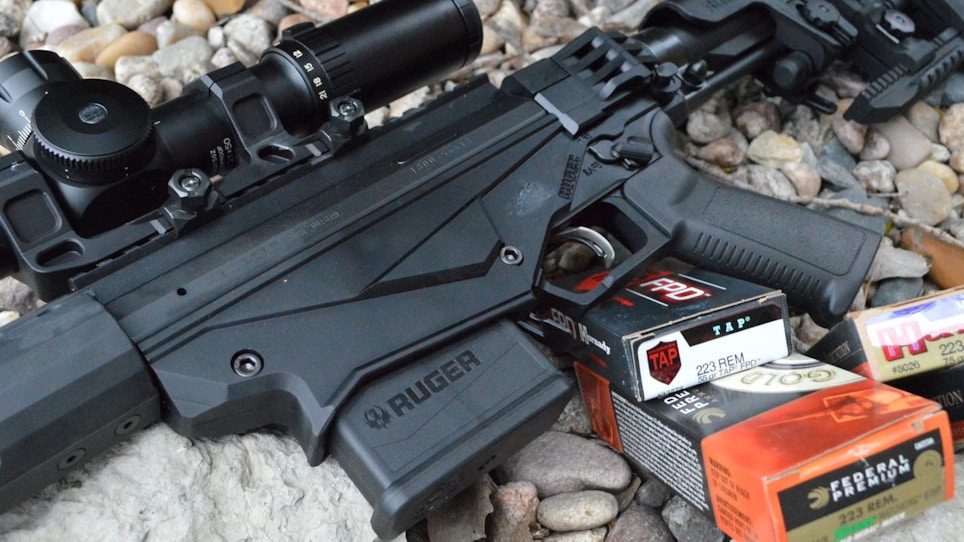Ruger shocked and stunned everyone when it introduced the Ruger Precision Rifle, now dubbed the RPR. Many dealers already know the RPR is loaded with top-end features and upgrades, all in a rifle that can actually print tiny groups and retails for around $1,500 on the street.
Well into 2017, the RPR was still breaking sales records for Ruger and shops are happily attempting to keep these rifles in stock. Ruger’s Mark Gurney noted the RPR has been a home run for Ruger, its dealers and its customers.
“We have more demand for the RPR than we can supply for the foreseen future, and our customers can get in the long-range game for relatively easy money — and not make any apologies for their rifle,” Gurney said.
Ruger is continuing to keep the lineup fresh with a V2 model and some upgraded components based on customer feedback during rifle competitions, as well as with the introduction of the 6mm Creedmoor model last year for the competitive shooting community. In 2017, Ruger offered a .223/5.56 NATO model that should keep dealers happy with yet another Ruger-inspired sales burst. Ruger is sure to pull in plenty of shooters who want a nice precision rifle for target shooting, training or varmint hunting that feels like a full sized .308 or 6.5 Creedmoor, but is cheap to shoot.
The net of all this excitement and low in-store stock levels is that, in many cases, the RPR is maintaining pre-election margins for dealers. Several dealers I spoke with at the 2017 SHOT Show noted that customers were willing to pay nearly full retail price just to get their hands on one. “The rifle is still in very high demand,” Gurney said.
Ruger is getting behind dealers with programs like the Ruger 4R program that allows dealer salespeople to earn points on verified sales that they can use toward Ruger products and firearms. For example, most firearms sold will typically earn five or 10 points for a seller, and only 75 points is required to purchase a Ruger LCR. Each RPR sale earns a seller 10 points. Ruger has made the incentives very attainable. The seller signs up for the program and provides verified proof of the sales via the R4 interface, and then the seller’s points begin adding up. The seller can then redeem those points for select Ruger accessories and firearms. Over the course of a year, an employed seller at an FFL can easily earn enough points to redeem for a firearm or even several.
Ruger has also been actively involved with shooting event sponsorship, training sponsorship and programs. The Ruger brand has been quietly sponsoring many long-range shooting matches around the United States, and unsurprisingly, there are more and more RPRs showing up at those matches.
“We are marketing across our brand and not tailoring our goodwill (advertising) around a rifle that sells itself and simply doesn't need any calling card,” Gurney said.
"We provide all sorts of pistols, revolvers and rifles for the prize table at various matches and fundraising events, but we rarely single out a particular product line.”
Ruger has always been a sponsor across the competition shooting sports; however, now we are seeing them at precision rifle competition matches, as well.
The Ruger Precision Rifle .223 Shoots As Well
As a trainer, even if the Ruger .223 Precision Rifle is used to practice only trigger pull, grip, shooting position, general marksmanship tactics and perhaps hammer a few critters in the process, the gun would pay for itself in ammo savings in only a few thousand rounds.
Really, I have to tell you those insanely accurate Hornady 6.5 Creedmoor ELD Match rounds are not cheap. The Hornady .223 equivalent are half the price of 6.5CM, and a good reload recipe could deliver further savings. Many shooters fall into a shooting segment who want a training gun that allows shots and shooting position work without blasting two-dollar rounds down range. There are a lot of range days when we want to feel like we are shooting the big gun or are training a new shooter, but just do not want to shell out the cash.
Another category for .223 RPR buyers are those who do not want to add managing yet another caliber to their firearm inventory. For them, the huge selection of .223 ammo for match, plinking, hogs and other game is enough as an addition to their AR-15. The price point, precision and user-friendly nature of the .223 RPR makes it a perfect fit for those shooters.
Most would expect that the .223/5.56 NATO RPR would duplicate the larger calibers in size, length and weight, and it does. In fact, this rifle is exactly the same weight as the .308 model. Ruger did go with a .223/5.56 NATO chambering, presumably some type of .223 Wylde chamber, which Ruger notes is completely cross compatible between the calibers. Ruger includes a five-groove 1:7-inch rifling to stabilize heavy, longer bullets better and AICS .223 magazines that allow 77-grain or heavier .223 bullets to fit, function and feed. It’s worth noting the .223 RPR is only compatible with Remington Short Action .223 AICS-size magazines.
Accuracy Test

The author's best accuracy was with Federal's Gold Medal Match, which produced this .38-inch group at 100 yards.
As with all the other RPRs, the .223 model is also a tack driving 1/2-MOA gun with the right match ammo. I tested a number of .223 Hornady and Federal rounds including Hornady 68-grain, 75-grain and TAP 55-grain; PMC Bronze 55-grain; Federal Match 68-grain Sierra MatchKing; and standard M855 steel core penetrator rounds.
The RPR performs best with high-grade match ammo. The best two 100-yard groups were Federal SMK 68-grain at 0.38-inch, and Hornady Match 75-grain at 0.38-inch. The Federal SMK 68-grain round was also the clear accuracy favorite in my test averaging 0.45-inch across all three of the three-round groups.
100-Yard Groups
Federal Match 68-grain Sierra MatchKing — 0.44-inch, 0.38-inch, 0.54-inch
Hornady 68-grain Match — 0.60-inch, 0.69-inch, 0.53-inch
Hornady 75-grain — 0.74-inch, 0.38-inch, 0.77-inch
Hornady TAP 55-grain — 0.70-inch, 0.77-inch, 0.65-inch
PMC Bronze 55-grain — 1.91-inch, 1.72-inch, 1.39-inch
GI standard M855 — 2.49-inch, 2.81-inch, 0.30-inch
Final Thoughts
The .223/5.56 RPR package adds up to a gun that shoots extremely well, is stunningly accurate for the price and is loaded with pretty much everything you could want in a precision rifle for far less than any other offering on the market. Ruger — simply an amazing gun for the price. Now, where is my rimfire variant?
SPECS
Stock: Folding, adjustable length of pull and comb height
Barrel Length: 20 inches
Barrel: Cold hammer-forged, 5R rifling
Handguard: Ruger Precision Rifle Short-Action
Twist: 1:7-inch RH
Grooves: Five
Weight: 9.8 pounds
Magazine Capacity: 10
Overall Length: 39.25 - 42.75 inches
Length of Pull: Adjustable from 12 to 15.50 inches
Folded Length: 31.60 inches
Suggested Retail: $1,599






